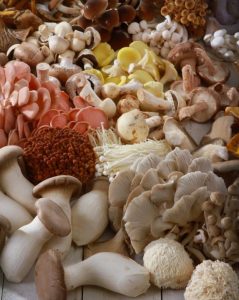Half our family loves mushrooms.
The other half? They pick them out—some even complain!
So when I planned a visit to a local mushroom farm, I thought it would be a fun and educational experience for my farm boys. I was wrong. They missed out on the best part!
You see, those who avoid mushrooms are skipping out on some of the most flavorful, versatile, and nutrient-dense foods around. And the health benefits? Incredible! But for my boys, it wasn’t the taste that drove them away—it was the smell.
The mushroom growing room has a very… distinct aroma. A mix of sawdust and spores that fills the air. For those who love mushrooms, it’s the scent of something earthy and full of life. For my little skeptics? It was enough to keep them at the door.
Sadly, that small farm didn’t survive the challenges of Covid, but our trusted partner, Primordia Mushroom Farm, is still going strong—bringing us the best gourmet mushrooms around. They’re dedicated to growing incredible, nutrient-packed mushrooms for our local community, and I hope you’ll fall in love with them even more after watching this video.
🎥 Come along on our mushroom farm visit below!
Then, grab the Mushroom & Goat Cheese Salad recipe—and don’t forget to shop for your mushrooms, fresh greens, and goat cheese so you can enjoy this dish and many more farm-fresh meals this week!
Try this Arugula, Mushroom, Walnut & Goat Cheese Salad—fresh, flavorful, and so easy to make! Click here for the recipe! 🍄🥗
MEAL IDEAS FOR YOUR LOCAL ORGANIC FOOD THIS WEEK:
Many of these recipes include produce or other items you may have received in your market box. You may also see ingredients you can purchase at the WHF General Store. Experiment and see what you can use to create your meal plan!
💡Pro tip: Always check your recipes to see what you have and what you need to purchase. Takes a few extra minutes in planning, but it beats finding out at the last minute that you’re missing ingredients!
FEATURED: Mushrooms, Greens, and Chèvre
As we reach the period between the winter and spring vegetable seasons, mushrooms are a great strategy for keeping your meals interesting. Now is the perfect time to try the artisan mushroom sampler. For even more ways to use mushrooms check out the links in the mushroom section of this blog post!
Appetizers:
- Milk, cream, goat cheese, and chives are all you need to make this 15-minute Goat Cheese Mousse Appetizer.
- This Goat Cheese Appetizer with Honey, Fig, and Pistachios takes only five minutes and doesn’t even need a recipe!
Breakfast:
- Add goat cheese to your scrambled eggs, either crumbled on top or mixed right in.
- Spread chevre on toasted sourdough bread and top with your favorite jam or honey for a quick and simple breakfast.
- Try tomato and goat cheese breakfast toasts if you prefer something a little more savory.
Lunch:
- Make a roasted vegetable and mushroom sandwich. Spread chevre on toasted sourdough bread with fresh ground black pepper. Add pesto, avocado, or your favorite greens.
- Try a grilled goat cheese sandwich with either pesto or jam for a lunchtime twist.
Main Dish Meals:
- For these still-chilly March evenings, creamy Goat Cheese Pasta with Spinach and Roasted Mushrooms is delicious comfort food without feeling too heavy.
- 💡Tip: Use tangy goat cheese in pasta recipes for indulgent taste without heavy cream or butter.
- Arugula and Goat Cheese Pasta Salad takes 15 minutes and makes a great lunch! Or serve with rustic Hungarian Mushroom Soup for a bit of warmth to your meal.
- 💡Tip: A mix of mushrooms works best for this one. The artisan mushroom sampler from Primordia Farms would be perfect!
- Fettuccine with Mushrooms, Tarragon, and Goat Cheese Sauce is so easy you don’t even have to cook the sauce!
- Make this Mushroom and Spinach Frittata with Goat Cheese for an easy weeknight dinner. Serve with a side salad or other vegetable side dishes. For a heartier meal, serve with some WHF sausage or another protein you love.
- 💡Tip: Customize by swapping out either of the vegetables or the goat cheese for whatever you have on hand.
- 💡Pro Tip: This frittata works just as well for brunch when served with a side of fruit and some warm sourdough bread.
- Looking for a meatier dinner option that uses mushrooms? Beef Stroganoff uses mushrooms or try this Easy Stir-Fried Beef with Mushrooms and Butter. The combination of butter and soy sauce creates a creamy sauce that brings out the richness of the meat.
- 💡Tip: Mushroom Stroganoff is also delicious!
Salads:
- When you want salad but still need something warm this Warm Mushroom and Spinach Salad is the answer. Serve sautéed red onions and mushrooms on fresh green spinach (or use arugula) and top with creamy chèvre. The result is a fantastic mix of temperatures and textures.
- 💡Tip: Use your favorite variety of Kirchenberg Farms chèvre.
- Warm Goat Cheese Salad with a Spicy Dressing is both sweet and savory. It’s easy and can be adapted any way you like. A great option for when you run out of dinner ideas any time of year.
- Try these arugula salad ideas:
Dessert!:
- Goat Cheese Cake with Mixed Berries is a fun, slightly savory twist on traditional cheesecake.
- Dark Chocolate Goat Cheese Brownies with Honey are super easy and so delicious.
- 💡Tip: Milk chocolate works too!
- Goat Cheese Mousse with Roasted Blueberries takes just 20 minutes to make.
- 💡Tip: Adapt this recipe based on the seasons and the fruits you have available. Be creative and have fun!
BREAD:
- Add a loaf (or two) of farm-baked sourdough bread to your market box to make appetizers, sandwiches, and toasts this week.
DAIRY:
- Pick up some plain or flavored chèvre from our friends at Kirchenberg Farms for the recipe ideas above.
- Make sure you have plenty of butter, raw milk, and eggs for your baking plans.
MEAT:
- Flank steak is perfect for the beef and mushroom stir fry recipe.
- Make sure you have pasture-raised ground beef if you plan on making stroganoff.
PANTRY RECOMMENDATIONS:
- Pasta! We have a great selection of pasta and noodles for your recipe needs. And it never hurts to have an extra box or bag on hand for last-minute meals.
- Look through our selection of oils and vinegars for making your salad dressings or choose from Christina Maser bottled vinaigrettes.
- Check out our jam and preserve options for your recipes. The fig and honey conserve from Tait Farm looks perfect for the goat cheese appetizer.
FRUIT:
Storage for all apple varieties:
Keep unwashed apples in a plastic bag in the refrigerator’s crisper drawer, where they can stay fresh for up to two weeks.
 Apples, Golden Delicious – Golden Delicious apples are a versatile variety with a sweet, mellow flavor and a crisp yet tender texture. They are high in fiber, vitamin C, and antioxidants, which support digestion, immune health, and skin health. These apples retain their shape and flavor, making them excellent for eating fresh, baking pies, making sauces, or adding to salads.
Apples, Golden Delicious – Golden Delicious apples are a versatile variety with a sweet, mellow flavor and a crisp yet tender texture. They are high in fiber, vitamin C, and antioxidants, which support digestion, immune health, and skin health. These apples retain their shape and flavor, making them excellent for eating fresh, baking pies, making sauces, or adding to salads.
 Apples, Pink Lady – Pink Lady apples are a crisp, juicy apple variety with a balanced sweet-tart flavor and a vibrant pinkish-red skin. They are high in fiber, vitamin C, and antioxidants, promoting heart health, immune support, and skin health. Pink Lady apples hold their shape well so they are great for snacking, adding to salads, or baking.
Apples, Pink Lady – Pink Lady apples are a crisp, juicy apple variety with a balanced sweet-tart flavor and a vibrant pinkish-red skin. They are high in fiber, vitamin C, and antioxidants, promoting heart health, immune support, and skin health. Pink Lady apples hold their shape well so they are great for snacking, adding to salads, or baking.
 Grapefruit – Grapefruit is a citrus fruit known for its juicy, tangy-sweet flavor with a slight bitterness. It is rich in vitamin C, fiber, and antioxidants like lycopene, promoting immune health, heart health, and skin health. Grapefruit can be eaten fresh, added to salads, or juiced for a refreshing drink. Store whole grapefruit at room temperature for up to a week or in the refrigerator for up to three weeks.
Grapefruit – Grapefruit is a citrus fruit known for its juicy, tangy-sweet flavor with a slight bitterness. It is rich in vitamin C, fiber, and antioxidants like lycopene, promoting immune health, heart health, and skin health. Grapefruit can be eaten fresh, added to salads, or juiced for a refreshing drink. Store whole grapefruit at room temperature for up to a week or in the refrigerator for up to three weeks.

Lemon – Lemons are tangy citrus fruits packed with vitamin C, antioxidants, and citric acid, which aid digestion, boost immunity, and enhance skin health. They are commonly used to add flavor to beverages, marinades, dressings, and desserts or as a natural cleaning agent. Store lemons at room temperature if using them soon or refrigerate them in a perforated bag to extend their shelf life up to 3-4 weeks.
 Orange, Mandarin – These small, sweet citrus fruits have a thin, easy-to-peel skin. They are high in vitamin C, fiber, and flavonoids, supporting immune function, digestion, and heart health. Mandarins are perfect for snacking, adding to desserts, or tossing into salads. Store them at room temperature for a few days or refrigerate to extend freshness for up to two weeks.
Orange, Mandarin – These small, sweet citrus fruits have a thin, easy-to-peel skin. They are high in vitamin C, fiber, and flavonoids, supporting immune function, digestion, and heart health. Mandarins are perfect for snacking, adding to desserts, or tossing into salads. Store them at room temperature for a few days or refrigerate to extend freshness for up to two weeks.
 Orange, Navel – Navel oranges are sweet, seedless, and easy to peel, making them an excellent snack or addition to salads and desserts. They are high in vitamin C, fiber, and antioxidants, which promote immune health and support heart health. Store navel oranges at room temperature for up to a week or refrigerate them in a mesh bag for up to three weeks to maintain freshness. Wash before peeling or slicing.
Orange, Navel – Navel oranges are sweet, seedless, and easy to peel, making them an excellent snack or addition to salads and desserts. They are high in vitamin C, fiber, and antioxidants, which promote immune health and support heart health. Store navel oranges at room temperature for up to a week or refrigerate them in a mesh bag for up to three weeks to maintain freshness. Wash before peeling or slicing.
 Mango – This tropical fruit is known for its juicy, sweet, and slightly tangy flavor. It’s rich in vitamin C, vitamin A, and fiber, supporting immune health, vision, and digestion. Mangoes can be eaten fresh, blended into smoothies, added to salsas, or used in desserts. Store unripe mangoes at room temperature until they soften, then refrigerate ripe ones for up to a week.
Mango – This tropical fruit is known for its juicy, sweet, and slightly tangy flavor. It’s rich in vitamin C, vitamin A, and fiber, supporting immune health, vision, and digestion. Mangoes can be eaten fresh, blended into smoothies, added to salsas, or used in desserts. Store unripe mangoes at room temperature until they soften, then refrigerate ripe ones for up to a week.
Fun Fact: Mangoes belong to the same plant family as cashews and pistachios!
Organic Veggies We Harvested This Week:
To help you use everything in your box this week, use this Meal Planning Guide to keep track of what’s in the fridge, what needs to be used first, and what you have planned or prepped for each day.
Every member’s customized Market Box is unique so we hope you will take advantage of more varieties of vegetables as you get comfortable with all the great organic produce we are offering.
Tessa’s Tips
What to use first: pears, greens, mushrooms
Longest Storage: apples, beets, carrots, Jerusalem artichokes, potatoes
Pro-tip: Look at the items in your market box right away and decide how you will use them in your meal planning for the week. Freeze any veggies you know you won’t be able to eat in the week.

Arugula – This leafy green has a peppery, slightly bitter flavor and is commonly used in salads, sandwiches, and as a garnish. It is low in calories and packed with vitamins A, C, and K, as well as folate and antioxidants, which support eye health, immune function, and bone strength. Arugula can be eaten fresh or lightly wilted in pasta dishes and pizzas. Some prefer to eat it tossed with other fresh greens or lettuce so that the spicy taste is not as strong. Putting it on a sandwich is another delicious way to enjoy its distinct flavor. Store wrapped in a paper towel inside a loosely sealed plastic bag in the refrigerator crisper drawer. Properly stored, arugula can stay fresh for up to 3-5 days. For best quality, use arugula soon after purchasing.
Arugula isn’t just for salad. Here are 29 Ways to Eat Arugula including pasta dishes, pizza, sandwiches, and more.
 Beet, Golden – Golden beets are a vibrant yellow-orange variety of beetroot with a mild, sweet flavor that is less earthy than red beets. They are packed with fiber, potassium, manganese, vitamin C, and antioxidants, contributing to heart health, digestion, and immune support. Their bright color makes them a visually appealing and nutritious addition to meals, and they don’t stain like their red counterparts. They can be roasted, steamed, or boiled for salads and side dishes, blended into soups, or shredded raw for slaws. Store unwashed beets in the fridge, ideally in a plastic bag or container for up to two weeks. Separate the greens (if attached) and store in a sealed container or bag. Use within a few days.
Beet, Golden – Golden beets are a vibrant yellow-orange variety of beetroot with a mild, sweet flavor that is less earthy than red beets. They are packed with fiber, potassium, manganese, vitamin C, and antioxidants, contributing to heart health, digestion, and immune support. Their bright color makes them a visually appealing and nutritious addition to meals, and they don’t stain like their red counterparts. They can be roasted, steamed, or boiled for salads and side dishes, blended into soups, or shredded raw for slaws. Store unwashed beets in the fridge, ideally in a plastic bag or container for up to two weeks. Separate the greens (if attached) and store in a sealed container or bag. Use within a few days.
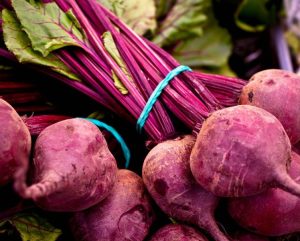 Beet, Red – Red beets are root vegetables known for their earthy flavor and vibrant red-purple color. They are rich in nutrients like folate, manganese, potassium, dietary fiber, and antioxidants such as betalains, which help reduce inflammation and support heart health. Both the roots and greens are edible, with the greens offering additional nutrients like vitamins A and C. Beets can be eaten raw in salads, roasted, boiled, or blended into smoothies and soups. Store beet greens separately from the root, wrapped in a damp cloth or in a plastic bag in the fridge. Use within a few days – they don’t keep long. Beetroots can be stored in a plastic bag in the fridge’s crisper drawer for up to two weeks. To freeze beets for longer storage, slice or chop them, spread on a cookie sheet to flash freeze, then transfer to freezer bags where they can be stored for up to a year.
Beet, Red – Red beets are root vegetables known for their earthy flavor and vibrant red-purple color. They are rich in nutrients like folate, manganese, potassium, dietary fiber, and antioxidants such as betalains, which help reduce inflammation and support heart health. Both the roots and greens are edible, with the greens offering additional nutrients like vitamins A and C. Beets can be eaten raw in salads, roasted, boiled, or blended into smoothies and soups. Store beet greens separately from the root, wrapped in a damp cloth or in a plastic bag in the fridge. Use within a few days – they don’t keep long. Beetroots can be stored in a plastic bag in the fridge’s crisper drawer for up to two weeks. To freeze beets for longer storage, slice or chop them, spread on a cookie sheet to flash freeze, then transfer to freezer bags where they can be stored for up to a year.
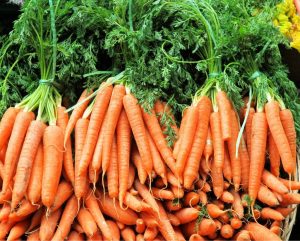 Carrot – Carrots are a versatile and popular root vegetable, known for their sweet, crunchy texture and vibrant orange color, though they can also be found in purple, yellow, and red varieties. They are rich in beta-carotene, which the body converts to vitamin A, essential for good vision and immune health. Carrots are a good source of dietary fiber, potassium, and antioxidants. Enjoy them raw, cooked, roasted, or juiced. They can be used in salads, soups, stews, and side dishes. For optimal storage, store carrots unwashed in the fridge, preferably in a plastic bag or container to maintain moisture, where they can last for several weeks. If the greens are attached, cut them off to prevent the carrots from becoming limp. Stored properly, they should last around 1-2 weeks.
Carrot – Carrots are a versatile and popular root vegetable, known for their sweet, crunchy texture and vibrant orange color, though they can also be found in purple, yellow, and red varieties. They are rich in beta-carotene, which the body converts to vitamin A, essential for good vision and immune health. Carrots are a good source of dietary fiber, potassium, and antioxidants. Enjoy them raw, cooked, roasted, or juiced. They can be used in salads, soups, stews, and side dishes. For optimal storage, store carrots unwashed in the fridge, preferably in a plastic bag or container to maintain moisture, where they can last for several weeks. If the greens are attached, cut them off to prevent the carrots from becoming limp. Stored properly, they should last around 1-2 weeks.

Carrot, Rainbow – In addition to the nutritional benefits above, rainbow carrots stand out from standard orange carrots with their vibrant colors—purple, yellow, red, and white—each offering unique nutritional benefits and distinct flavors. Purple carrots contain anthocyanins, powerful antioxidants linked to anti-inflammatory and heart-health benefits, with a slightly earthy, spicy taste. Yellow carrots are rich in lutein, which promotes eye health by protecting against macular degeneration and cataracts, and they have a mild, subtly sweet flavor. Red carrots contain lycopene, a potent antioxidant that supports heart health, reduces the risk of certain cancers, and helps protect skin from UV damage, with a richer, sweeter taste.
These colorful carrots are perfect for adding visual appeal to dishes and enhancing the taste profile, whether roasted to bring out their natural sweetness, or sliced raw for salads. Their distinct flavors can also add depth to juices and smoothies. The diverse hues, flavors, and nutrients of rainbow carrots make them perfect for garnishes or serving as part of a vegetable medley. Store rainbow carrots the same way you would store standard orange carrots.
 Celery – Celery is a crunchy, low-calorie vegetable known for its mild, slightly salty flavor. It is rich in vitamins K and C, folate, potassium, and fiber, supporting bone health, digestion, and hydration. Celery is often eaten raw as a snack, added to salads, or used as a base in soups, stews, and stir-fries. Store celery in the refrigerator, tightly wrapped in aluminum foil to retain its crispness, where it can stay fresh for up to two weeks. For longer storage, celery can be chopped and frozen.
Celery – Celery is a crunchy, low-calorie vegetable known for its mild, slightly salty flavor. It is rich in vitamins K and C, folate, potassium, and fiber, supporting bone health, digestion, and hydration. Celery is often eaten raw as a snack, added to salads, or used as a base in soups, stews, and stir-fries. Store celery in the refrigerator, tightly wrapped in aluminum foil to retain its crispness, where it can stay fresh for up to two weeks. For longer storage, celery can be chopped and frozen.
Don’t forget to use those celery greens! They’re a great addition to cooked beans, salads, eggs. Use leaves to make pesto or dry them and make your own parsley flakes, powder, or salt.
 Ginger – Ginger is a flavorful root widely used as a spice and natural remedy. It has a warm, slightly spicy taste and is rich in bioactive compounds like gingerol, which has anti-inflammatory and antioxidant properties. Ginger aids digestion, relieves nausea, and supports immune health. It is versatile in cooking, and used in teas, curries, stir-fries, baked goods, and beverages. Store fresh ginger in a cool, dry place for short-term use or in the refrigerator in a paper towel or airtight bag for extended freshness. For long-term storage, freeze peeled or sliced ginger.
Ginger – Ginger is a flavorful root widely used as a spice and natural remedy. It has a warm, slightly spicy taste and is rich in bioactive compounds like gingerol, which has anti-inflammatory and antioxidant properties. Ginger aids digestion, relieves nausea, and supports immune health. It is versatile in cooking, and used in teas, curries, stir-fries, baked goods, and beverages. Store fresh ginger in a cool, dry place for short-term use or in the refrigerator in a paper towel or airtight bag for extended freshness. For long-term storage, freeze peeled or sliced ginger.
Freeze your fresh ginger for longer storage: Peel and slice or grate the ginger. Freeze in an airtight container or ice cube tray. You can also freeze the whole unpeeled root in a freezer bag. Grate or slice directly from frozen as needed.
 Jerusalem Artichoke – Jerusalem artichokes, or sunchokes, are nutty, slightly sweet tubers loaded with iron, potassium, and inulin, a fiber that supports digestion. They can be roasted, added to soups or stews, eaten raw in salads, or mashed as a potato substitute. Store them unwashed in a cool, dark place or in a paper bag in the fridge, where they can last up to 2–3 weeks.
Jerusalem Artichoke – Jerusalem artichokes, or sunchokes, are nutty, slightly sweet tubers loaded with iron, potassium, and inulin, a fiber that supports digestion. They can be roasted, added to soups or stews, eaten raw in salads, or mashed as a potato substitute. Store them unwashed in a cool, dark place or in a paper bag in the fridge, where they can last up to 2–3 weeks.
Fun Facts: Despite the name, Jerusalem artichokes are not related to artichokes—they’re actually a type of sunflower root! They are also known as sunchokes. They’re sometimes called earth apples or sunroot because they’re the edible tubers of a type of sunflower.

Lettuce, Loose Leaf – Leaf lettuce, known for its loose, leafy structure and mild, slightly sweet flavor, comes in green and red varieties. It is a low-calorie vegetable packed with vitamins A, C, and K, as well as folate and fiber, making it a nutritious choice for salads and wraps. Its tender leaves are best used raw in salads, sandwiches, or as a garnish. Store leaf lettuce in the refrigerator, loosely wrapped in a damp paper towel inside a plastic bag or container, and use it within a week to maintain freshness and crispness.
Mushroom Varieties
Store mushrooms in a paper bag or breathable container in the refrigerator, avoiding moisture buildup, and only wash them right before use to maintain freshness.
Mushrooms are super versatile in the kitchen. Here are 10 Things You Should Do With Mushrooms.
This roundup of 20 Mushroom Recipes has you covered with meal ideas for breakfast, lunch, or dinner.
Mushroom, Portobello & Cremini – Portobello mushrooms are mature versions of cremini mushrooms, offering a meaty texture and rich, earthy flavor. Cremini, also known as “baby bellas,” are younger, smaller, and have a firmer texture with a milder taste. Both are low in calories, fat-free, cholesterol-free, and provide B vitamins, selenium, potassium, and antioxidants. Portobellos are ideal for grilling, roasting, or as a meat substitute in burgers, sandwiches, or stuffed recipes. Creminis are great for sautéing, adding to soups, stir-fries, pasta dishes, or as pizza and salad toppings.
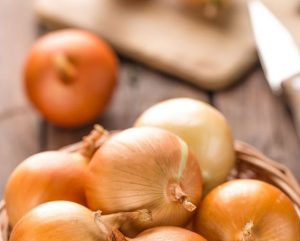
Onion, Yellow – Yellow onions are a popular, versatile vegetable with golden-brown skin and a strong, savory flavor that mellows and sweetens when cooked. Rich in antioxidants, vitamin C, and fiber, yellow onions support immune health, digestion, and overall cellular health. They’re a staple in many cuisines, perfect for sautéing, caramelizing, roasting, and adding depth to soups, stews, and sauces. To store, keep unpeeled yellow onions in a cool, dry, well-ventilated place, away from potatoes, where they can last up to a month; once peeled or cut, store them in an airtight container in the refrigerator for up to a week.
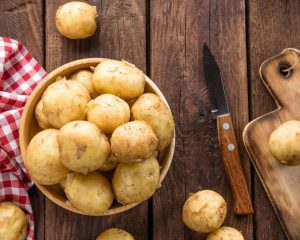 Potato, Yellow – Also known as Yukon Gold or gold potatoes, yellow potatoes have smooth, thin, yellowish skin and creamy, buttery-flavored flesh. They are slightly waxy, making them versatile in cooking. Yellow potatoes are a good source of vitamin C, potassium, and fiber and are low in calories and fat. Their creamy texture makes them ideal for mashing, roasting, grilling, and boiling. They are also excellent in gratins and salads because they hold shape during cooking. Store yellow potatoes in a cool, dark, and well-ventilated place for several weeks, avoiding refrigeration as it can alter their texture and flavor.
Potato, Yellow – Also known as Yukon Gold or gold potatoes, yellow potatoes have smooth, thin, yellowish skin and creamy, buttery-flavored flesh. They are slightly waxy, making them versatile in cooking. Yellow potatoes are a good source of vitamin C, potassium, and fiber and are low in calories and fat. Their creamy texture makes them ideal for mashing, roasting, grilling, and boiling. They are also excellent in gratins and salads because they hold shape during cooking. Store yellow potatoes in a cool, dark, and well-ventilated place for several weeks, avoiding refrigeration as it can alter their texture and flavor.
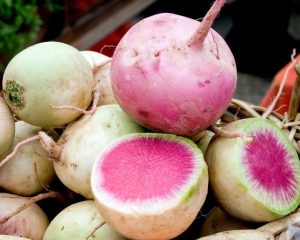 Radish, Watermelon – Watermelon radish is a striking root vegetable with a mild, slightly sweet flavor and a crisp texture. Its pale green skin hides a vibrant pink interior, resembling a watermelon. Rich in vitamin C, potassium, and antioxidants, it supports immune health and reduces inflammation. Watermelon radishes can be enjoyed raw in salads, sliced thinly for garnishes, pickled, or roasted for a milder flavor. Store unwashed watermelon radishes in a perforated plastic bag in the refrigerator, where they can stay fresh for up to two weeks. Wash and trim just before using.
Radish, Watermelon – Watermelon radish is a striking root vegetable with a mild, slightly sweet flavor and a crisp texture. Its pale green skin hides a vibrant pink interior, resembling a watermelon. Rich in vitamin C, potassium, and antioxidants, it supports immune health and reduces inflammation. Watermelon radishes can be enjoyed raw in salads, sliced thinly for garnishes, pickled, or roasted for a milder flavor. Store unwashed watermelon radishes in a perforated plastic bag in the refrigerator, where they can stay fresh for up to two weeks. Wash and trim just before using.
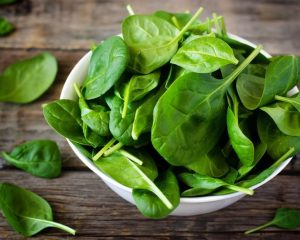 Spinach – Spinach is a nutrient-rich leafy green vegetable packed with vitamins A, C, K, and folate, along with minerals like iron and magnesium. Low in calories and high in antioxidants, it supports eye health, bone strength, and immune function. Spinach is versatile and can be enjoyed raw in salads, blended into smoothies, or cooked in soups, pasta, and omelets. To store, keep it dry in a perforated plastic bag in the fridge’s crisper drawer, and wash only before use. Properly stored, it stays fresh for 5-7 days.
Spinach – Spinach is a nutrient-rich leafy green vegetable packed with vitamins A, C, K, and folate, along with minerals like iron and magnesium. Low in calories and high in antioxidants, it supports eye health, bone strength, and immune function. Spinach is versatile and can be enjoyed raw in salads, blended into smoothies, or cooked in soups, pasta, and omelets. To store, keep it dry in a perforated plastic bag in the fridge’s crisper drawer, and wash only before use. Properly stored, it stays fresh for 5-7 days.
 Sweet Potato – Sweet potatoes are a nutritious root vegetable known for their naturally sweet flavor and vibrant orange flesh, though they also come in other colors like purple and white. They are rich in vitamins A (as beta-carotene), C, and B6, as well as dietary fiber, potassium, and antioxidants. These nutrients support eye health, boost immunity, and promote digestive health. Sweet potatoes are versatile in cooking and can be baked, roasted, mashed, or used in soups and stews. They can also be enjoyed in both savory and sweet dishes. Store sweet potatoes in a cool, dark, well-ventilated place for several weeks, avoiding refrigeration as it can affect their texture and flavor.
Sweet Potato – Sweet potatoes are a nutritious root vegetable known for their naturally sweet flavor and vibrant orange flesh, though they also come in other colors like purple and white. They are rich in vitamins A (as beta-carotene), C, and B6, as well as dietary fiber, potassium, and antioxidants. These nutrients support eye health, boost immunity, and promote digestive health. Sweet potatoes are versatile in cooking and can be baked, roasted, mashed, or used in soups and stews. They can also be enjoyed in both savory and sweet dishes. Store sweet potatoes in a cool, dark, well-ventilated place for several weeks, avoiding refrigeration as it can affect their texture and flavor.
Don’t Forget: Online shopping opens Friday at 3 PM! 🛒 Stock your kitchen with these clean, nourishing ingredients to fuel your family with nutrient-dense meals. Be sure to grab your favorite staples and try something new for vibrant health this winter.
Don’t wait to join…
Veggie E-Books
Download these collections of tips and recipes for each veggie. You’ll use these as a reference throughout the season.
Arugula E-Book
Beets E-Book
Carrots E-Book
Kale E-Book
Lettuce E-Book
Mushrooms E-Book
Onions E-Book
Potatoes E-Book
Radish E-Book
Spinach E-Book
~~~~~
Farm News and Events
💦 Intro to Hydration with Aga Kastelik – Health and Wellness Professional, Certified H2 Advisor with Molecular Hydrogen Institute
This introductory class explores the fundamental role of water in human health and introduces the emerging science of molecular hydrogen.
Join us on Saturday, March 8, 2025 from 11:00 AM to 12:00 noon to learn about:
- The biochemical functions of water in the body
- Hydration’s impact on cognitive function, physical performance, and cellular health
- How molecular hydrogen may offer unique therapeutic benefits
- The latest research on hydrogen’s potential as an antioxidant and signaling molecule
~~~~~
🍞 Next Sourdough Bread Baking Workshop – Sign Up!
Get ready for a fun, hands-on experience in the art of sourdough bread making!
Join us on Saturday, March 29, 2025, for our Sourdough Bread Baking Workshop at Willow Haven Farm.
Whether you’re a beginner or a seasoned baker, this workshop will give you the skills and confidence to bake delicious, homemade sourdough bread from scratch.
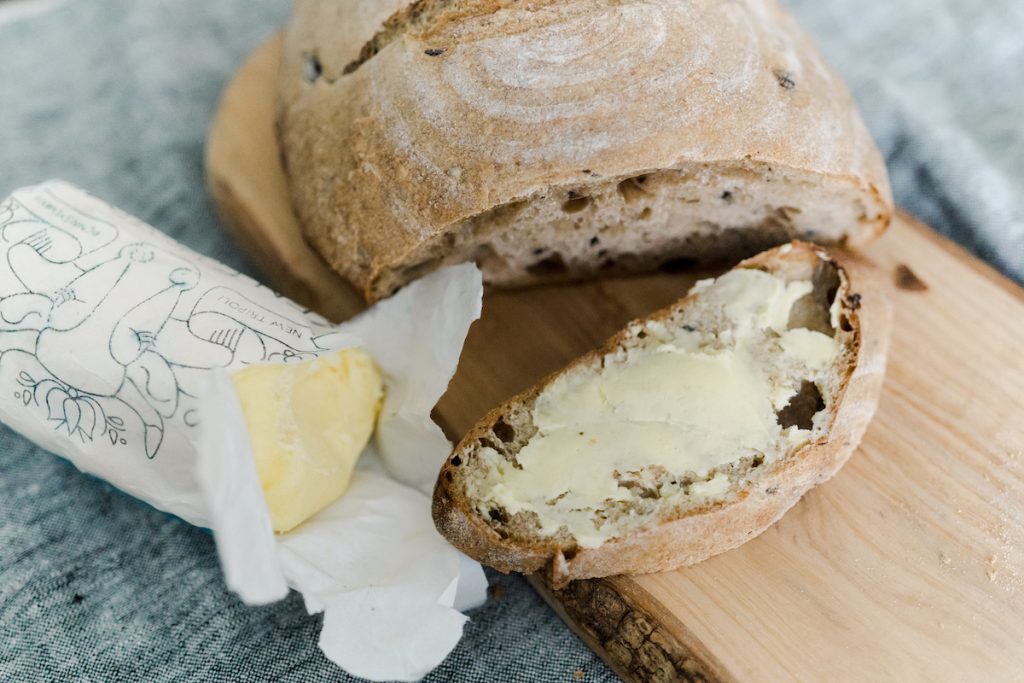
👩🍳 What to Expect on March 29th:
- Step-by-step guidance from our expert instructor
- Hands-on experience making your own sourdough starter
- Tips for perfecting your bread at home
- A chance to meet other bread enthusiasts in a fun, relaxed environment
✨ Don’t miss out on this opportunity to take your baking to the next level!
We’ll keep farming for you!
Reuben and Tessa DeMaster
Willow Haven Farm


